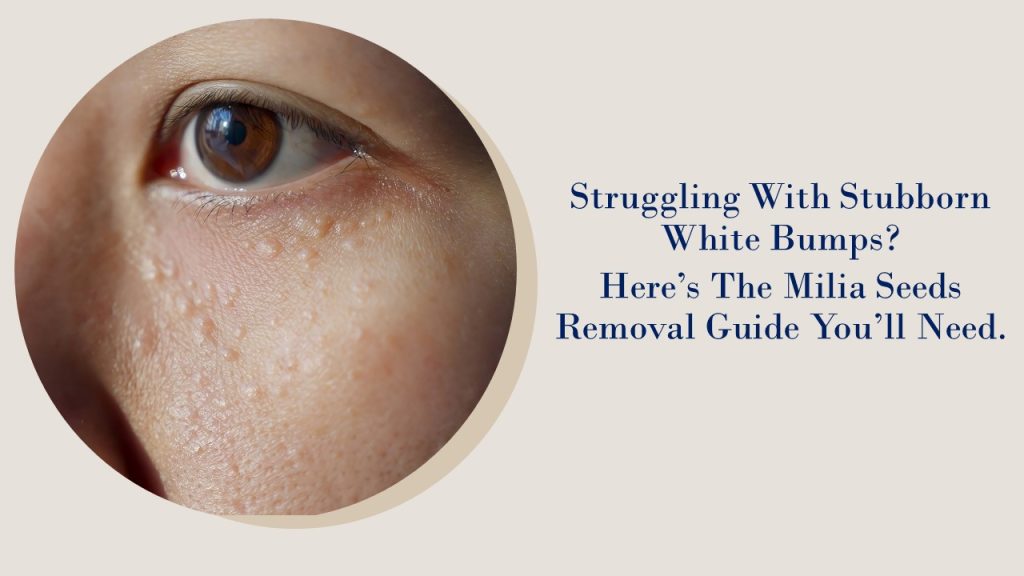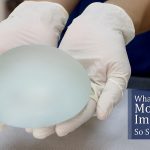Milia seeds, often confused with acne, are small, white bumps on the skin. It’s crucial to understand and correctly identify milia to ensure appropriate treatment and avoid mistreatment. In Singapore, pigmentation laser treatment is a popular procedure; however, it’s essential to distinguish between pigmentation issues and milia seeds to choose the right treatment.
What Are Milia Seeds?
Milia seeds are small, dome-shaped bumps that appear on the skin, often characterised by their white or yellowish colour. These benign cysts are about 1-2 millimetres in size and are filled with keratin, a protein that’s a key structural component of hair, skin, and nails. Unlike acne, milia are not caused by clogged pores but are instead the result of keratin becoming trapped beneath the skin’s surface.
Milia seeds can occur in individuals of any age, though they are particularly common in newborns, where they typically disappear on their own. In adults, they can persist for longer periods and might require treatment for removal. These cysts are typically found in areas with delicate skin, such as the face – especially around the eyes, cheeks, and nose – but they can appear anywhere on the body.
While milia seeds are generally painless and not harmful, they can be a cosmetic concern for many. They don’t usually cause any discomfort, itching, or irritation unless they become inflamed or irritated due to external factors like harsh skincare products or excessive touching and picking.
What Causes Milia Seeds?
The formation of milia seeds is a result of keratin, a natural skin protein, becoming trapped beneath the skin’s surface, forming small cysts. This entrapment can happen for several reasons:

1. Skin Cell Renewal Process: As skin cells naturally die and are replaced, they can sometimes get trapped under the skin’s surface instead of being shed. This is more likely in areas where the skin is thin or has less exfoliation, like around the eyes.
2. Damaged Sweat Glands: Sometimes, damaged or improperly functioning sweat glands can contribute to the development of milia. This is because they can lead to the accumulation of skin cells and keratin.
3. Skin Trauma: Any form of skin injury, from sunburns and blisters to more invasive dermal procedures like laser treatments or dermabrasion, can cause milia as the skin heals. The healing process can lead to the trapping of keratin in small pockets beneath the skin.
4. Use of Certain Skincare Products: Heavy, oil-based creams or certain cosmetic products can lead to milia, especially if they clog pores and prevent the natural exfoliation process. This is particularly true for products used around the eyes, a common area for milia.
5. Long-term Sun Damage: Chronic sun exposure can thicken the skin, particularly the epidermis, making it harder for dead skin cells to exfoliate naturally. This build-up can result in the formation of milia.
6. Genetic Factors: Some individuals may have a genetic predisposition to developing milia, indicating that hereditary factors can play a role.
7. Hormonal Changes: Hormonal fluctuations, such as those experienced during puberty, pregnancy, or menopause, can affect the skin in various ways, including the potential to trigger the development of milia.
Understanding these causes is crucial for both the prevention and effective treatment of milia seeds. It also helps in identifying lifestyle or skincare changes that might be necessary to reduce the likelihood of their occurrence. For persistent milia or if they are a cause for concern, it is always advisable to consult an experienced doctor for appropriate advice and treatment.
Are Milia Seeds Concerning?
Milia seeds, while usually benign and not a health concern, can sometimes cause aesthetic or psychological distress. Here are some considerations to keep in mind:

1. Cosmetic Concern: For many, milia can be a source of self-consciousness, especially when they occur in visible areas like the face. They can be particularly troubling if they are numerous or form clusters.
2. Physical Discomfort: In rare cases, milia can cause minor physical discomfort, especially if they are located in sensitive areas such as the eyelids.
3. Potential for Infection: If attempts are made to remove milia at home, especially through squeezing or picking, there is a risk of infection or scarring. It’s crucial to resist the urge to remove them this way and seek professional help instead.
4. Indicator of Other Skin Issues: While milia themselves are harmless, their presence can sometimes be a sign of underlying skin conditions or indicate that the skin isn’t being exfoliated effectively. This could prompt a review of one’s skincare routine or a consultation with an experienced doctor.
5. Persistence and Spread: In some cases, milia don’t resolve on their own and may even spread or increase in number. This can be a cosmetic concern for many people, prompting the need for professional treatment.
6. Psychological Impact: Like any visible skin condition, milia can affect an individual’s self-esteem and confidence, especially if they feel it impacts their appearance.
7. Rare Complications in Newborns: In newborns, milia are usually harmless and resolve on their own. However, if they are widespread or persist for an extended period, it may be advisable to consult a paediatrician.
While milia seeds are typically not concerning from a medical standpoint, they can have cosmetic and psychological implications. Professional advice can be sought for persistent milia, both to address aesthetic concerns and to ensure they are not symptoms of another skin condition.
Why Shouldn’t I Pick My Milia Seeds?
Picking or attempting to remove milia seeds at home is strongly discouraged for several reasons:

1. Risk of Infection: When you try to pick or squeeze milia, you risk introducing bacteria from your hands or tools into your skin. This can lead to infections, which can be more problematic and harder to treat than the milia themselves.
2. Scarring: Milia are located deep within the skin’s layers, and removing them forcibly can cause significant damage to the surrounding tissue. This trauma can result in scarring, including indented scars (atrophic scars) or raised scars (hypertrophic scars or keloids), which are often more noticeable than the milia.3
3. Unsuccessful Removal: Milia are encased in a protein-rich cyst wall that is not easily penetrated. Unlike acne, which can sometimes be extracted, milia are more resistant to simple extraction methods. Home removal attempts often fail to completely remove the cyst, leading to recurrence or even worsening of the condition.
4. Irritation and Damage to Skin Barrier: Picking at your skin can disrupt its natural barrier, leading to dryness, sensitivity, and irritation. This can exacerbate skin problems and delay healing.
5. Spreading Milia: Improper removal techniques can potentially cause Milia to spread or create new ones in adjacent areas, especially if the area becomes inflamed or infected.
6. Potential for Misdiagnosis: Without a professional evaluation, what you believe to be milia could be another skin condition. Treating it as milia and attempting removal could exacerbate the actual condition.
Given these risks, it is always advisable to consult an experienced doctor for safe and effective milia removal. They can provide treatments that minimise risks and promote healing, ensuring the best outcome for your skin’s health and appearance.
Different Types of Milia Seeds
Milia seeds come in various types, each with its unique characteristics and potential causes. Understanding these types can help in identifying the most appropriate treatment strategies:

1. Primary Milia:
- Neonatal Milia: Common in newborns, appearing on the nose, cheeks, and forehead. These usually resolve without treatment within a few weeks of birth.
- Adult Primary Milia: Appears spontaneously in adults, often around the eyes, cheeks, and forehead. They can be persistent and might require professional removal.
2. Secondary Milia:
- Traumatic Milia: Result from skin injuries like burns, blisters, or extensive sun damage. They can also occur after certain skin procedures, such as dermabrasion or laser treatments.
- Drug-Induced Milia: Some medications, particularly topical steroids, can lead to the development of milia as a side effect.
3. Milia en Plaque:
- This rare type is characterised by milia clustered on an inflamed, raised patch of skin. It’s most commonly found in middle-aged women and can be associated with autoimmune skin disorders.
4. Multiple Eruptive Milia:
- These appear as sudden outbreaks of milia, which develop over weeks to months. They typically form on the face, upper arms, and torso.
5. Juvenile Milia:
- Linked to genetic disorders, these types of milia are present from birth or develop in early childhood.
6. Congenital Milia:
- Present at birth, these milia are similar to neonatal milia but may be associated with other congenital conditions.
7. Milia associated with Genodermatoses:
- These are milia that occur as part of a genetic syndrome and may be seen in conditions like basal cell nevus syndrome or Gardner’s syndrome.
8. Milia from Skin Inflammation:
- Occurring in areas of the skin that have experienced chronic inflammation, these can be a reaction to inflammatory skin conditions.
9. Milia from Topical Steroids:
- Prolonged or inappropriate use of potent topical corticosteroids can lead to the development of milia.
Each type of milia may require a slightly different approach to treatment, and in some cases, their presence can indicate underlying health issues. For instance, milia en plaque may require a more comprehensive approach due to its potential association with autoimmune conditions. An experienced doctor can provide a precise diagnosis and recommend the most appropriate treatment based on the type of milia present.
Milia Seeds Removal: Treatment Methods
Milia seeds, those small yet noticeable white cysts on the skin, often require professional treatment for effective removal. Here are three common methods used by certified doctors, along with their pros and cons, expected outcomes, downtime, and aftercare advice.
Method 1: CO2 Laser Removal
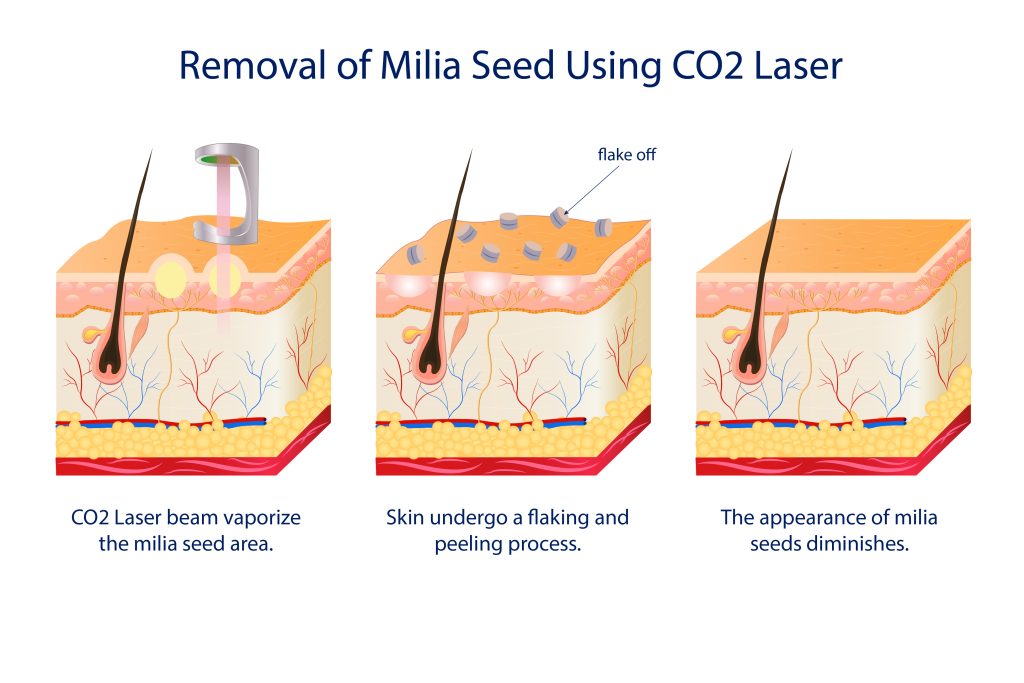
Why Doctors Choose This Option:
- CO2 Laser Removal is preferred for its precision and effectiveness. It’s particularly effective for extensive or deeply-rooted milia seeds.
- The laser targets and vaporises the milia, minimising damage to the surrounding skin.
Pros and Cons:
- Pros: High precision, minimal risk of scarring, effective on various skin areas.
- Cons: Potential temporary hyperpigmentation, especially in darker skin tones.
Expectation and Downtime:
- Quick procedure, usually one session.
- Mild discomfort during treatment, with a brief recovery period.
- Patients can resume normal activities shortly, avoiding strenuous tasks for a few days.
Aftercare:
- Mild redness or swelling may occur, subsiding within a few days.
- Follow a gentle skincare routine and avoid direct sunlight.
Method 2: Cauterization Using Electrical Pulses
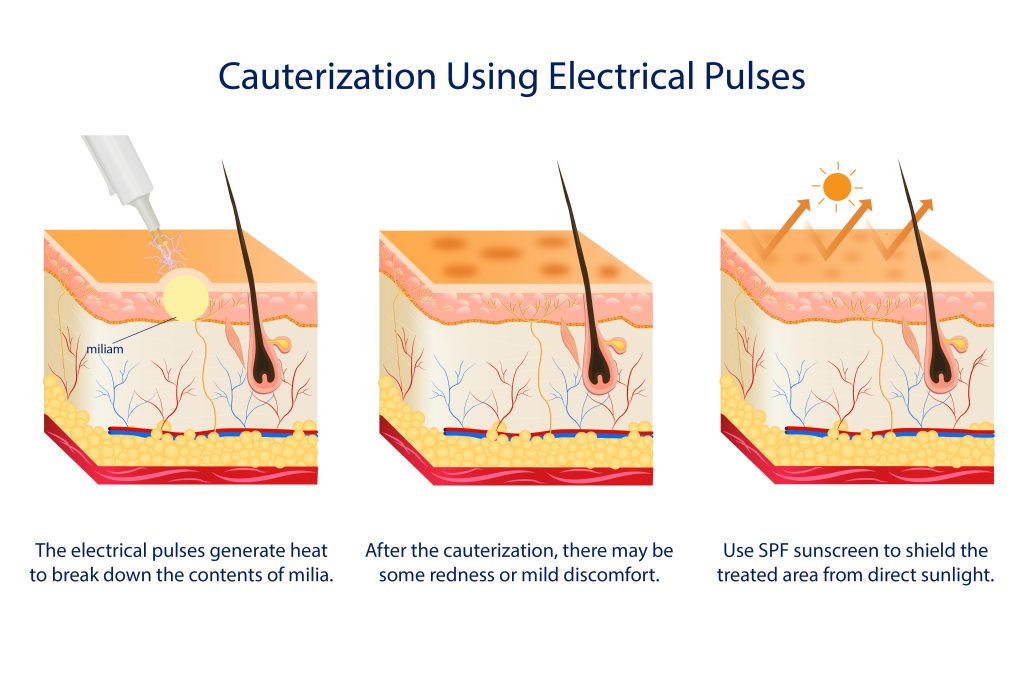
Why Doctors Choose This Option:
- Ideal for smaller or superficial milia.
- Electrical pulses effectively cauterise the milia, reducing the likelihood of recurrence.
Pros and Cons:
- Pros: Precise, less invasive, suitable for smaller milia.
- Cons: Risk of temporary skin discolouration or mild discomfort during the procedure.
Expectation and Downtime:
- The procedure is quick, with immediate results.
- Minimal downtime; patients can usually return to daily activities immediately.
Aftercare:
- The skin may be slightly red or sensitive post-treatment.
- Avoid exposure to intense heat or sunlight and follow a soothing skincare regimen.
Method 3: Surgical Scraping or De-roofing
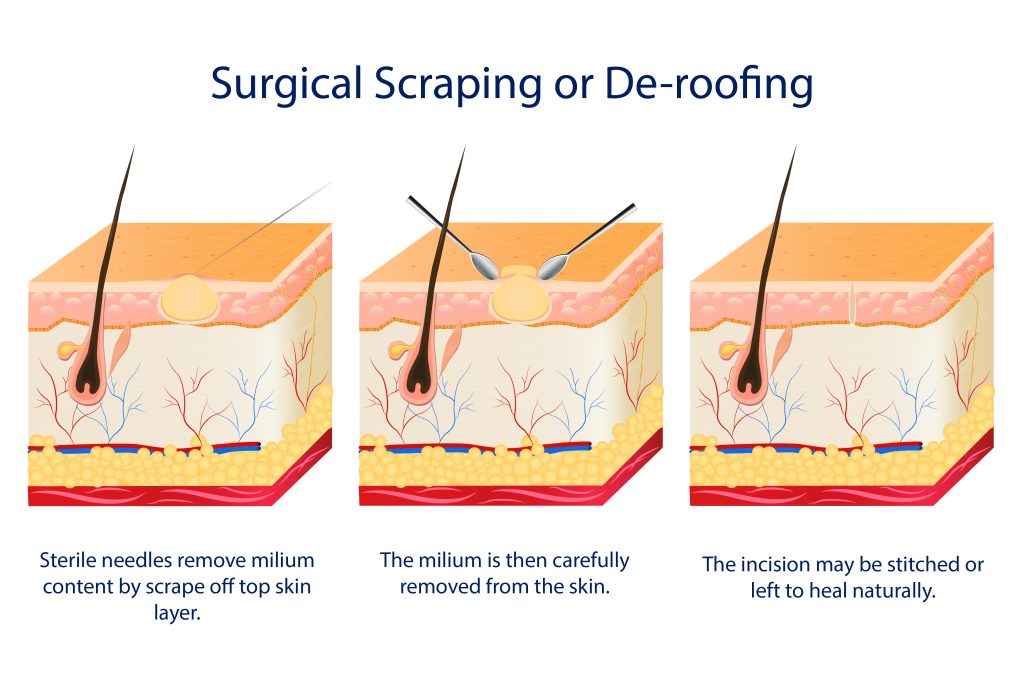
Why Doctors Choose This Option:
- Recommended for stubborn or large milia seeds.
- This method ensures complete removal of the cyst’s contents.
Pros and Cons:
- Pros: High success rate in milia removal.
- Cons: More invasive with a higher risk of scarring.
Expectation and Downtime:
- The procedure involves using sterile needles for extraction.
- Slightly longer recovery period due to the invasive nature of the treatment.
Aftercare:
- Post-treatment care includes wound care to prevent infection.
- Avoid aggressive skin treatments until fully healed.
Advice for Managing Milia Seeds
1. Choose Light Moisturizers: Select non-comedogenic and oil-free moisturisers to hydrate your skin. These products provide necessary moisture without clogging pores, which is essential in preventing the formation of milia. Heavy, greasy creams are more likely to exacerbate the condition, especially in areas prone to milia, like around the eyes.
2. Apply Broad-Spectrum Sunscreen: Sun protection plays a vital role in skin health. Use a broad-spectrum sunscreen with an SPF of at least 30 to shield your skin from harmful UV rays. Prolonged sun exposure can lead to skin thickening and damage, increasing the risk of milia. Opt for sunscreens that are oil-free and non-comedogenic to avoid clogging pores.
3. Avoid Harsh Skincare Products: Be cautious with your skincare choices. Harsh products and aggressive treatments can irritate the skin and potentially lead to the development of more milia. This includes avoiding products with abrasive ingredients or those that strip the skin of its natural oils. Gentle, soothing skincare products are preferable, especially for those with sensitive skin or prone to milia.
Final Thoughts
Milia seeds, while not harmful, can be an aesthetic concern. Understanding their types and causes is the first step in addressing them. While home remedies can be effective for milder cases, professional treatments offer a more reliable solution for persistent milia.
FAQs
1. Can you remove milia seeds?
Yes, milia seeds can be removed. Small milia often disappear on their own, especially in infants, but in adults, they can persist and may require intervention. Professional treatments such as laser therapy, cryotherapy, or manual extraction are effective. It’s important not to attempt removal at home as this can lead to scarring or infection.
2. Will Milia seed go away by itself?
While small milia may naturally resolve, especially in infants, adults may find persistent milia requiring additional care. Natural remedies involve gentle exfoliation and maintaining a good skincare routine. Products with AHAs or BHAs can aid in exfoliation and prevent new milia. Keeping the skin well-moisturized with non-comedogenic products is essential. However, natural methods might not work for everyone, particularly for persistent or numerous milia. Seeking professional advice from a certified doctor is recommended for persistent cases.
3. What causes milia seeds?
Milia seeds are caused by the buildup of keratin, a natural protein in the skin, under the surface. This can be due to various factors, including skin trauma, use of heavy skincare products, or genetic predispositions. Understanding the underlying cause is important in preventing future occurrences and choosing the right treatment.
4. How do I get rid of deep milia?
Deep milia, also known as primary milia, are often more challenging to remove and typically require professional treatment. Techniques like CO2 laser therapy, microneedling, or surgical excision can be effective. An experienced doctor should perform these procedures to minimise risks.

